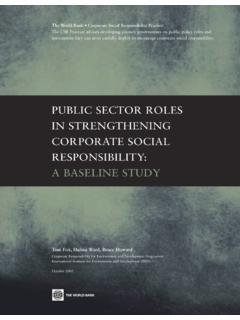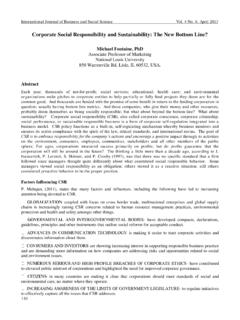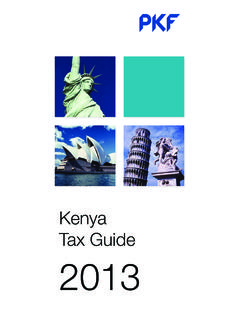Transcription of Mining and Sustainable Development: The Case of Ghana
1 Mining and Sustainable development : The case of Ghana Dr. Toni Aubynn Chief Executive Officer (CEO) The Ghana Chamber of Mines Outline of Presentation Overview of Mining in Ghana Sustainable Minerals development Legal and Regulatory Framework Mining s Contribution to the Economy of Ghana Transparency in the Mining Sector Conclusion 2 Mining in Ghana - An Overview Ghana s geological space is prospective with diverse kinds of minerals. Traditionally, those that are mined on a commercial basis include gold, bauxite, diamond and manganese. Others not fully exploited or not exploited include kaolin, salt, limestone, mica, feldspar, to mention a few. These minerals are mainly found in the Western, Eastern, Ashanti, Brong - Ahafo and sometimes in the Northern parts of Ghana . 3 Mining in Ghana -An Overview (CONTD) Mining in Ghana predates independence and over the years the sector has grown to be a major driver of economic growth.
2 Mining accounted for 6% of GDP in 2011 and the sector grew by in 2012. There are currently about thirteen (13) large scale Mining companies and 16 operations and over 1000 registered small- scale companies in the sector. Large scale companies are mainly foreign owned while small-scale Mining is a preserve of Ghanaians. 4 Sustainable Minerals development - Ghana s Approach By their nature, minerals are non-renewable and exhaustible. Yet their impact on the society, environment and economy of the host nation defies time. Consequently, the Ghana Chamber of Mines and its members have endeavoured to integrate these key 3 actors into their corporate decision making, in line with international best practices (Principle 2, ICCM). In this way, the mineral industry is integrated throughout the value chain and becomes a provider of mineral services rather than primary products 5 Sustainable Minerals development - Ghana s Approach Mining Firms Government Community Economy Environment 6 LEGAL & REGULATORY FRAMEWORK Government as a partner in Sustainable minerals development , provides a legal framework to ensure minimum standards of compliance.
3 The Legislative Framework for Mining in Ghana is currently laid down in the Minerals and Mining Act, 2006 (Act 703). Within this Legal Framework, the state is the owner of all minerals occurring in their natural state within Ghana 's land and sea territory, including its exclusive economic zone. LEGAL & REGULATORY FRAMEWORK (CONTD) The relevant agencies that regulate the Mining industry include the following: Ministry of Lands and Natural Resources - overall responsibility for the Mining industry. Minerals Commission has responsibility for administering the Mining Act, recommending mineral policy, promoting mineral development , advising the government on mineral matters, and serving as a liaison between industry and the government. Geological Survey Department - geological studies including map production and maintenance of geological records LEGAL & REGULATORY FRAMEWORK (CONTD) Inspectorate Division of the Minerals commission - health and safety inspections and maintenance of Mining records Lands commission - legal records of licenses and legal examination of new applications.
4 Environmental Protection Agency - overall responsibility for environmental issues related to Mining Mining s Contribution to the Economy of Ghana Fiscal Revenues Two kinds of fiscal revenues are provided by Mining . Revenues Direct Revenue includes mineral royalties, taxes, dividends and levies. 2. Indirect Revenues Indirect Revenue includes taxes and fees through the supply chain. 10 Highlights of Mining s Fiscal Contribution-2012 Foreign Exchange The industry accounts for about 42% of the country s gross export revenue reinforcing its position as the country s leading export earner and a major contributor to the country s balance of payment. The Mining industry returned about USD billion representing 72% of their mineral revenue through the BOG and the Commercial Banks in 2012. This has significant bearing on the international reserve position of BoG and the stability of the monetary system as a whole.
5 11 Total Mineral Revenues and Amounts Returned to the Country (2009-2012) 62%64%66%68%70%72%74%76%78%0500100015002 0002500300035004000450050002009201020112 012 Millions Total Mineral Revenue (USD)Mineral Revenue Returned (USD)% of Mineral Revenue Returned12 Highlights of Mining s Fiscal Contribution-2012 (CONT) Foreign Direct investment The sector is the leading attractor of FDI. Records from the Minerals Commission show that foreign direct investment (FDI) in the Mining sector shot up from US $6million in 1983 to US$1billion in 2011. These investments came from producing, exploration, and support service companies. Cumulatively, the investment inflow into the sector over $13b since SAP. 13 Highlights of Mining s Fiscal Contribution-2012 (CONTD) Number One Ta x Payer and highest contributor to GRA s Domestic Collections. Contributed about GH billion to GRA representing of GRA s To t a l Direct Ta xe s in 2012.
6 Paid GH million, in corporate tax to the GRA, representing of the total company tax collected in 2012. 14 Mining and Employment Creation Direct Employment The sector employs about 21,239 people directly; of which 334 representing 2% were expatriates. Indirect Employment Empirical evidence suggests that the number of indirect and induced jobs created by Mining is about six times the number of direct employee. The normal extended family support provided in Ghana by employees suggests that there are also 8-10 family members supported by each direct employee. 15 Mining and Human Resource development Training is another area in which the major Mining companies make significant contributions to Ghana . They include: Education and sensitization of employees and contractors in safety; a culture which is carried back to the community, home and family.
7 Apprenticeship programs especially for inadequately educated youth in rural districts e. g. London city & guilds certification program. 16 Mining and Human Resource development (CONT) Professional training and career development for senior Mining employees Ghanaian Mining professionals are now working as expatriates in many parts of the world. Graduate Training Programs for fresh products of the various universities. Research dissemination seminars at UMaT that bridge gap between practice and industry. 17 Mining and Local Content The Chamber of Mines and its members gave meaning to local content when they signed a memorandum of understanding with the Minerals Commission and IFC in 2011. The World Bank reckons that Ghana is leading the way in terms of local content strategy and development within the Mining industry. The total amount spent in-country on key big ticket items was US$ billion in 2012, representing 65% of mineral revenue.
8 18 2010 2011 2012 Amount Spent(USD) % share of mineral revenue Amount Spent(USD) % share of mineral revenue Amount Spent(USD) % share of mineral revenue Amortizing loans, including interest 230,905,746 7% 283,221,271 43,501,757 1% Imported Consumables 511,159,912 16% 647,485,259 775,746,303 17% Local Purchases 696,036,454 21% 771,920,186 1,294,939,887 29% Electric Power 168,052,032 5% 310,164,056 277, 858,731 6% Diesel 227,447,069 7% 322,163,134 343,569,366 8% Employees 292,303,804 9% 303,793,323 377,266,878 8% State 300,556,884 9% 540,469,790 614,872,549 14% Other Shareholders 27,000,000 1% 192,256,976 68,027,037 2% CAPEX 696,865,694 21% 821,061,062 1,132,639,366 25% Host Communities 17,590,469 1% 43,732,833 26,676.
9 354 1% Distributive Impact of Mineral Revenue 19 Mining and Community development In the Mining s e c t o r, Corporate Social Responsibility has evolved to Community Sustainable development Plans. Under this arrangement, Mining companies collaborate with the communities to fund projects that yield both social and economic returns to the communities. Mining companies focus on operating the core business in a socially responsible way, complemented by investment in communities and the society in general. In 2012, Mining companies voluntarily committed US$ 26million to CSD projects in their host community and the country. 20 Mining and Community development The channels for addressing issues on sustainability in the host communities are as follows: Community Consultative Committees: Each mine has established this committee with the primary focus of liaising with community members in identifying key socio-economic and environmental issues and finding a mutually acceptable remedy.
10 Community Relations Office: Each mine has a dedicated and well-resourced liaison office that actively promotes peaceful coexistence between the mine and community. Such offices are usually operated 24/7. Environmental Officers: Producing member companies engage the services of environmental officers to mitigate the impact of Mining on the environment. 21 Examples of CSDP Trust funds Funded through US$ 1 per ounce + 1 per cent of profit: Golden Star, Chirano, AngloGold Ashanti, Gold Fields, etc. Individual Company Initiatives: Examples include Sustainable Community Empowerment and Economic development (SEED) Gold Fields 5 year, 5 million US dollar Community Dev t Programme for the benefit of 8 primary stakeholder communities. Livelihood Enhancement & Community Empowerment Programme (LEEP) Newmont Ahafo Linkages Programme Newmont & IFC programme for small business dev t Agricultural Improvement & Land Access Programme (AILAP) for farmers Newmont and MOFA Post -Resettlement programme for resettled farmers 22 Examples of CSDP (CONT) Malaria Control Chirano Gold Mine launched a $ million-dollar four-year malaria control program to help bring down the disease in its operational area.











